
It is a bright morning on July 9, at the end of the Shandur polo festival that with a group of 6 people we start from Shandur over Chamarkand Pass to participate in the Broghil festival and to continue our trek over Darkhot pass further on to the Yasin valley. After night stay at the Chamarkand pass (4328m), we manage to get to the village Chapali (2500m), 8 kilometer north to Mastuj. This village is acknowledged for its traditional folksingers, folkdancers, solo sitar players and vocalists. We stay with Mr Akhtar Murad Khan, whose house perches atop the mountain overlooking the village.
The next morning we have a thorough visit to have glimpses of the women activities in handicraft, cooking and the rest of the household chore. We observe several women harvesting wheat crops. Many more are occupied with weaving traditional woolen carpet, goat-hair carpet and embroidered women cap. Every house we visit, we are warmly welcomed and presented with cherry and mulberry besides tea. Some of the group members buy the local woolen carpets and embroidered women caps. In the late afternoon we arrange a big cultural event in the wide orchard under the cool shadow of the fruit-bearing trees,, where ‘Lokzhore’ and ‘pasthok’—the two famous floksongs are showcased through the participation of the elderly folksingers and folkdancers. Some tourists also join the dance party and make a fun.
From this village to Lashkargaz (3660), the venue of the festival, it is about 3 days travel. We arrange a 4X4 Jeep—the only dependable source of transport in the mountains of the Hindukush—upto the end of the Brep village where the bridge that connects the upper Yarkhun valley is broken and hence we have to carry the entire luggage through the narrow and rickety pedestrian bridge to the other side, where we bargain with Mr Dawood, the driver, who will charge us Rs 8000 for Kishmanja (3300m), the beginning of Broghil. Our travel is interrupted once as we stop for lunch at Pawer, the house of Mr Hakim Jan, the renowned personality of the area. He is also a first-class sitar expert and plays some of the oldest piece of music to the cheer and appreciation of the guests. This place is the best camping site but we don’t have it in our schedule to stay here. Rather we continue for Yarkhunlasht (3048) after lunch.
After traveling half an hour from Pawer, we reach at another unsteady jeep-able bridge connecting the village of Sholcoach (2700m) to that of Zhopo to the right side of the Yarkhun River. We choose to get down for our safety and let the jeep pass unloaded. The road from here onward leads us through a narrow valley with big boulders slowing down the vehicle’s speed. We reach at Darband, a place where a war was fought between Chitralies and some people coming from across the Wakhan Corridor in the olden times. The bunkers and other signs of war installations are still here. We reach Yarkhun by the evening and manage to stay with Mr Mehboob, a social activist and a hospitable gentleman. We pitch our tents in his vast orchard and the cook prepares dinner of chicken and rice. We go to sleep earlier with eagerness to start another challenging travel the next morning.
It takes us 2 hours to reach Kishmanja. You don’t have vehicle beyond this point. If traveling by foot, either from or to Broghil, then you have to compulsorily stay at Kishmaja whether or not you like the idea. Here we meet Mr Momin Khan, who speaks Dari Persian and Wakhi language and is proud of his Central Asian ancestors. He is dressed in the self-made raw leather coat and shoes called ‘Kon’. Here the cook prepares our lunch whilst we send for horses at Pechuztch or ‘the hot spring’ around which the village has developed. We arrive at Chikar for night stay and camp outside in the open meadow. By the night we listen to dogs barking, donkeys braying and horses neighing. We feel rather abandoned in a high and dry place under the bold shine of stars in the pitch-dark.
We awake to the yellow sunrays on the glacier of Chikar (3570m) to the south and in the adjacent pastureland. The nomads here just gather around and look at us in disbelief and some of them really shy away. Young girls play flute as they tend livestock further up the pasture. Smoke from the makeshift nomadic shelters makes a wavy column against the sky whilst children and elderly people sit lazily in the morning sun. As the sun in the nearby Chikar glacier presents an incredible view, we take a good deal of snaps.
We ride the sure-hoofed mountain ponies for Skarwarz (3510), the venue of the Yak Polo festival. It takes 5 hours before we reach this place, which is a big pastureland shared by the entire Wakhi communities. Yaks, horses, donkeys, sheep and goats are being grazed here. The landscape is beautiful with a range of wild flowers such as edelweiss, the sight of which brings a broad smile in the face of our Swiss group member who elaborates that edelweiss is Switzerland’s national flower. Golden marmot is also found in abundant here. They make underground tunnel and live in a family system. Broghil, the eastern Pamir region, is a wetland, appropriate for a variety of flora and fauna. It is one of the biggest peat bogs in the country and the locals dig out and get them sun-dried for fuel to be used in the harshest of 6 months long winter every year.
The three-day festival is truly a moment of pleasure. Some of the foreign friends just go for playing yak polo. It is an uphill task to mount the unruly creature and score a goal or two. On the final day of the yak polo festival, we arrange barbecue party to a big bonfire. The foreign guests and locals join together to have a big feast that everyone relishes.
The next day early in the morning, we start for Darkhot pass (4650m). The glacier is lengthy, steep and uneven and thus much tiring. One has to be much careful about the crevices filled with blue water many hundred feet deep. We clear the hurdles skillfully and ultimately reach the meadow of Darkhot in about 12 hours. For night stay we reach Darkhot village.
The next morning we awake to witness the long poplar trees and the nearby Darkhot glacier. The weather is quite chilly here even in midsummer. We take turn to the south and walk through the villages of Terset, Sandi and finally on to Taus, headquarter of the Yasin valley, where we avail public transport to Gupis and further on to the Gilgit city.
Thus one of our adventurous treks comes to an end.
The next morning we have a thorough visit to have glimpses of the women activities in handicraft, cooking and the rest of the household chore. We observe several women harvesting wheat crops. Many more are occupied with weaving traditional woolen carpet, goat-hair carpet and embroidered women cap. Every house we visit, we are warmly welcomed and presented with cherry and mulberry besides tea. Some of the group members buy the local woolen carpets and embroidered women caps. In the late afternoon we arrange a big cultural event in the wide orchard under the cool shadow of the fruit-bearing trees,, where ‘Lokzhore’ and ‘pasthok’—the two famous floksongs are showcased through the participation of the elderly folksingers and folkdancers. Some tourists also join the dance party and make a fun.
From this village to Lashkargaz (3660), the venue of the festival, it is about 3 days travel. We arrange a 4X4 Jeep—the only dependable source of transport in the mountains of the Hindukush—upto the end of the Brep village where the bridge that connects the upper Yarkhun valley is broken and hence we have to carry the entire luggage through the narrow and rickety pedestrian bridge to the other side, where we bargain with Mr Dawood, the driver, who will charge us Rs 8000 for Kishmanja (3300m), the beginning of Broghil. Our travel is interrupted once as we stop for lunch at Pawer, the house of Mr Hakim Jan, the renowned personality of the area. He is also a first-class sitar expert and plays some of the oldest piece of music to the cheer and appreciation of the guests. This place is the best camping site but we don’t have it in our schedule to stay here. Rather we continue for Yarkhunlasht (3048) after lunch.
After traveling half an hour from Pawer, we reach at another unsteady jeep-able bridge connecting the village of Sholcoach (2700m) to that of Zhopo to the right side of the Yarkhun River. We choose to get down for our safety and let the jeep pass unloaded. The road from here onward leads us through a narrow valley with big boulders slowing down the vehicle’s speed. We reach at Darband, a place where a war was fought between Chitralies and some people coming from across the Wakhan Corridor in the olden times. The bunkers and other signs of war installations are still here. We reach Yarkhun by the evening and manage to stay with Mr Mehboob, a social activist and a hospitable gentleman. We pitch our tents in his vast orchard and the cook prepares dinner of chicken and rice. We go to sleep earlier with eagerness to start another challenging travel the next morning.
It takes us 2 hours to reach Kishmanja. You don’t have vehicle beyond this point. If traveling by foot, either from or to Broghil, then you have to compulsorily stay at Kishmaja whether or not you like the idea. Here we meet Mr Momin Khan, who speaks Dari Persian and Wakhi language and is proud of his Central Asian ancestors. He is dressed in the self-made raw leather coat and shoes called ‘Kon’. Here the cook prepares our lunch whilst we send for horses at Pechuztch or ‘the hot spring’ around which the village has developed. We arrive at Chikar for night stay and camp outside in the open meadow. By the night we listen to dogs barking, donkeys braying and horses neighing. We feel rather abandoned in a high and dry place under the bold shine of stars in the pitch-dark.
We awake to the yellow sunrays on the glacier of Chikar (3570m) to the south and in the adjacent pastureland. The nomads here just gather around and look at us in disbelief and some of them really shy away. Young girls play flute as they tend livestock further up the pasture. Smoke from the makeshift nomadic shelters makes a wavy column against the sky whilst children and elderly people sit lazily in the morning sun. As the sun in the nearby Chikar glacier presents an incredible view, we take a good deal of snaps.
We ride the sure-hoofed mountain ponies for Skarwarz (3510), the venue of the Yak Polo festival. It takes 5 hours before we reach this place, which is a big pastureland shared by the entire Wakhi communities. Yaks, horses, donkeys, sheep and goats are being grazed here. The landscape is beautiful with a range of wild flowers such as edelweiss, the sight of which brings a broad smile in the face of our Swiss group member who elaborates that edelweiss is Switzerland’s national flower. Golden marmot is also found in abundant here. They make underground tunnel and live in a family system. Broghil, the eastern Pamir region, is a wetland, appropriate for a variety of flora and fauna. It is one of the biggest peat bogs in the country and the locals dig out and get them sun-dried for fuel to be used in the harshest of 6 months long winter every year.
The three-day festival is truly a moment of pleasure. Some of the foreign friends just go for playing yak polo. It is an uphill task to mount the unruly creature and score a goal or two. On the final day of the yak polo festival, we arrange barbecue party to a big bonfire. The foreign guests and locals join together to have a big feast that everyone relishes.
The next day early in the morning, we start for Darkhot pass (4650m). The glacier is lengthy, steep and uneven and thus much tiring. One has to be much careful about the crevices filled with blue water many hundred feet deep. We clear the hurdles skillfully and ultimately reach the meadow of Darkhot in about 12 hours. For night stay we reach Darkhot village.
The next morning we awake to witness the long poplar trees and the nearby Darkhot glacier. The weather is quite chilly here even in midsummer. We take turn to the south and walk through the villages of Terset, Sandi and finally on to Taus, headquarter of the Yasin valley, where we avail public transport to Gupis and further on to the Gilgit city.
Thus one of our adventurous treks comes to an end.



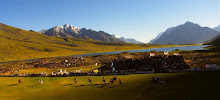



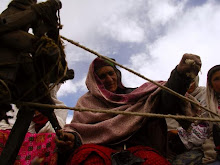
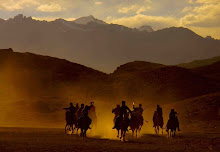

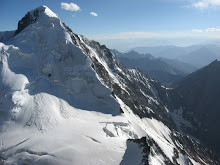
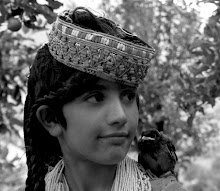


No comments:
Post a Comment